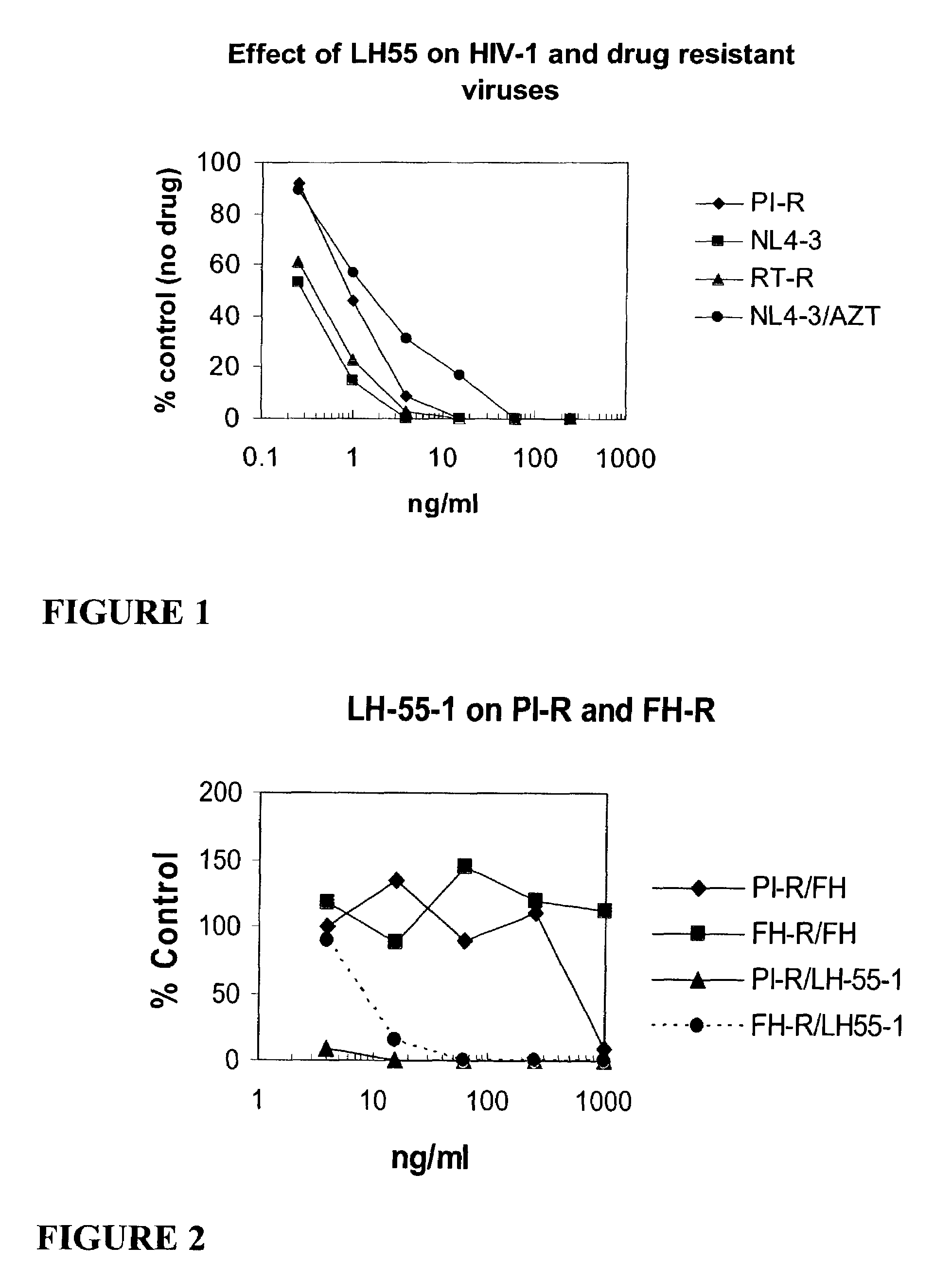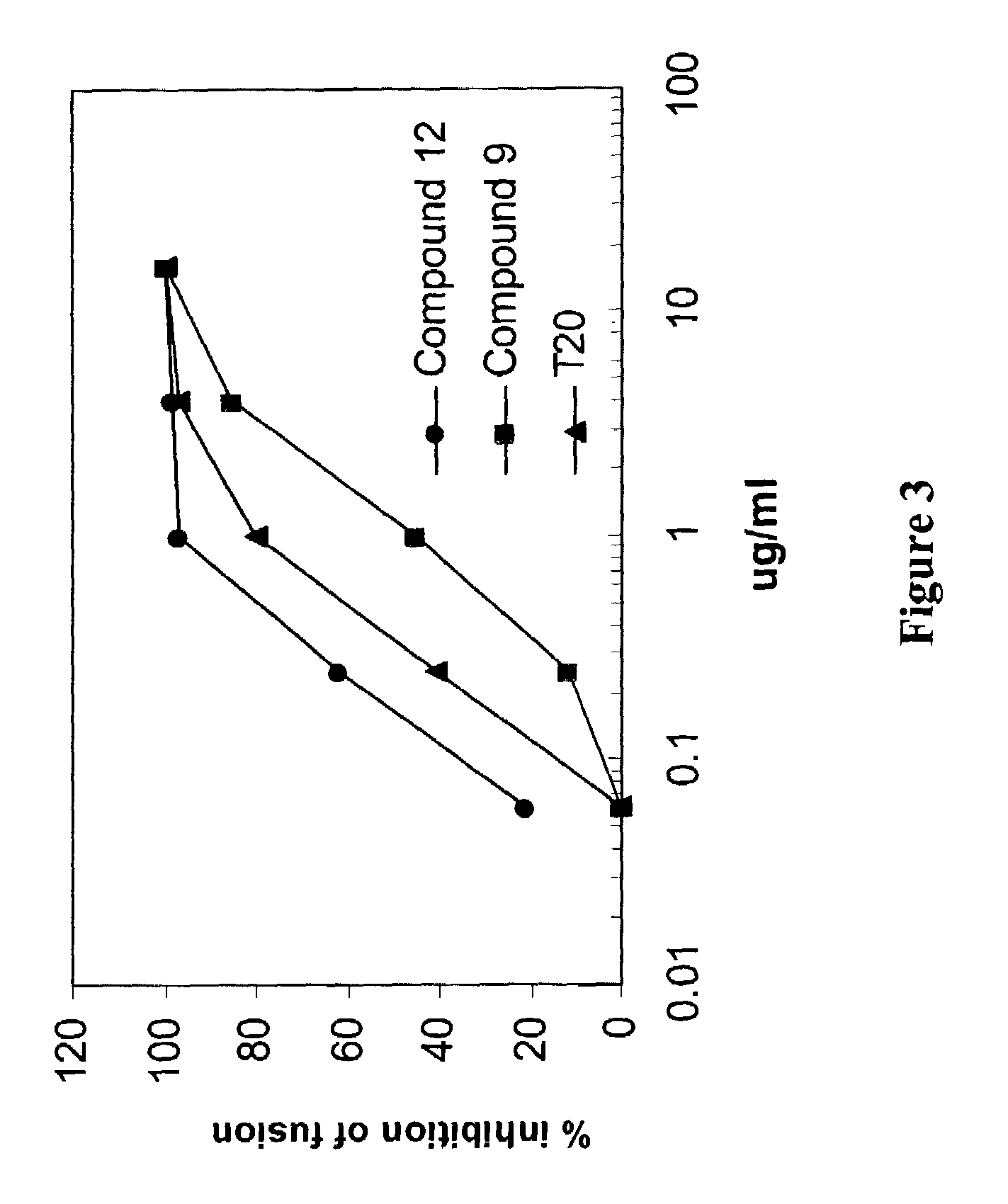Anti-HIV agents with dual sites of action
a technology of anti-hiv agents and sites of action, applied in the field of anti-hiv agents with dual sites of action, can solve the problems of severe toxicities, side effects, and many species susceptible to retroviral infection
- Summary
- Abstract
- Description
- Claims
- Application Information
AI Technical Summary
Benefits of technology
Problems solved by technology
Method used
Image
Examples
example 1
Synthesis of N-[3-O-(3′,3′-dimethylsuccinyl)-lup-20(29)-ene-28-oyl]leucine (compound 9)
[0215]The procedure to prepare 3-acyl betulinic acid (BA) is known. Briefly, the starting material betulinic acid (1) in anhydrous pyridine was added with acetic anhydride and DMAP, and refluxed for 4 hrs. The reaction mixture was cooled, then extracted with organic solvent and washed with water. The organic layer was concentrated and chromatographed on Si-gel to give 3-O-acetate BA as a white powder with a yield of 60%.
[0216]3-O-acetate BA was then dissolved in 2M (CO)2Cl2 and stirred for 1 hr. The reaction mixture was concentrated to dryness using N2. The resulting acid chloride (2) was used without purification (see Scheme I above).
[0217]The acid chloride (5) in dry DCM was added to the leucine methyl ester and was then added in a triethylamine solution. After stiffing for 8 hrs, the reaction was concentrated as described above and chromatographed on Si-gel to yield white powder 8 (72% yield). ...
example 2
[0221]FIG. 1 graphically illustrates the anti-HIV activity of Compound 12 (also called compound LH 55-1). In FIG. 1, PI-R represents a multiple HIV-1 protease inhibitor resistant strain of HIV-1. RT-R represents a multiple HIV-1 reverse transcriptase inhibitor resistant strain of HIV-1; NL4-3 represents a T-cell line adapted HIV-1 strain; and NL4-3 / AZT represents the effect of AZT on the NL4-3 virus. Note the substantial antiviral activity of compound 12 against all resistant strains.
[0222]FIG. 2 graphically illustrates that multiple protease inhibitor resistant strains of HIV-1 and DSB resistant HIV-1 are sensitive to Compound 12 (LH55-1). PI-R indicates a multiple HIV-1 protease inhibitor resistant strain of HIV-1, and FH-R indicates a DSB resistant HIV-1 strain (FH=DSB).
example 3
Inhibition of Membrane Fusion
[0223]To determine the mechanisms of action, the ability of LH55-1 and compound 9 to inhibit HIV-1 entry were analyzed by using a cell-cell fusion assay. Inhibition of HIV-1 envelope-mediated membrane fusion will prevent HIV-1 from entering into the cells. FIG. 3 shows that LH55-1 is a potent HIV-1 entry inhibitor that can block HIV-1 envelope-mediated membrane fusion at sub-micromolar concentrations. Compound 9 also exhibited anti-HIV-1 entry activity, albeit at higher concentrations than compound 12. T20 is a polypeptide fusion inhibitor recently approved for anti-HIV-1 therapy by FDA, USA.
PUM
| Property | Measurement | Unit |
|---|---|---|
| Structure | aaaaa | aaaaa |
| Pharmaceutically acceptable | aaaaa | aaaaa |
Abstract
Description
Claims
Application Information
 Login to View More
Login to View More - R&D
- Intellectual Property
- Life Sciences
- Materials
- Tech Scout
- Unparalleled Data Quality
- Higher Quality Content
- 60% Fewer Hallucinations
Browse by: Latest US Patents, China's latest patents, Technical Efficacy Thesaurus, Application Domain, Technology Topic, Popular Technical Reports.
© 2025 PatSnap. All rights reserved.Legal|Privacy policy|Modern Slavery Act Transparency Statement|Sitemap|About US| Contact US: help@patsnap.com



